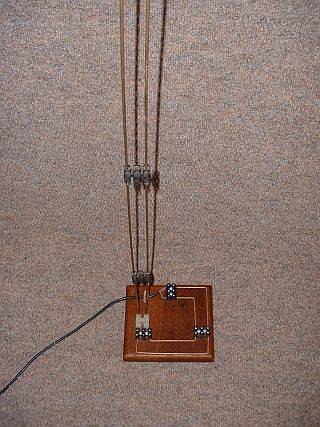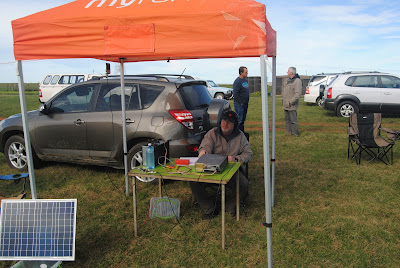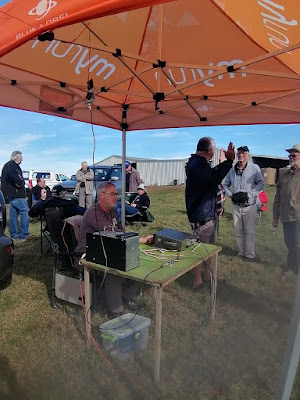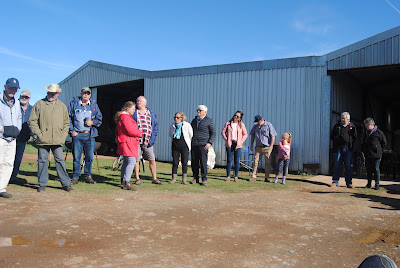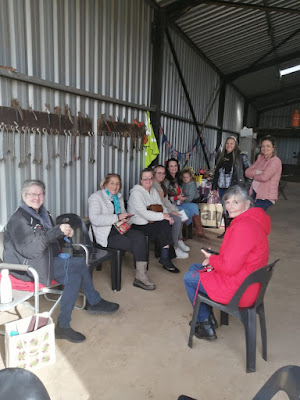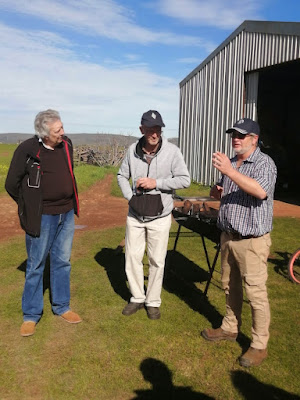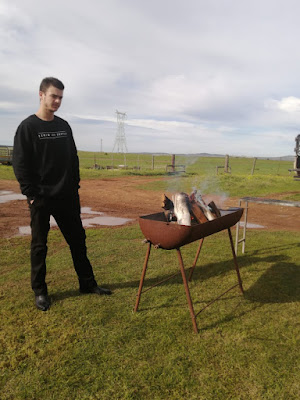Radio Amateurs: (Links na regs agter) Gerrit ZS1KLO, Danie ZS1DL, Jimmy ZS1RB, Henk ZS1AAD, Thys ZS1TBP, Marco ZS1NEU, Johan ZS1I, Ingo ZS1IB, Mark ZS1SSM. (Regs na links voor) Elna ZS1EAS, Albie ZS1SE, Nick ZS1NS, Jasper ZS1WT, Michael ZS1MMB, Rassie ZS1RP, Nick ZS1N, Nicoleen ZS1HAR en Johann ZS1AAC. Inlas fotos: Lynnore ZS1DPW en Dolf ZS1DRP.
Radio Amateurs, Gades, Vriende en Jongmense: (Links na regs agter) Gerrit, Jan, Danie, Jimmy, Thys, Johan, Nick, Ingo, Mark, Joanie, Henk. (Regs na links voor) Rassie, Rola, Nechita, Elna, Albie, Louisa, Jasper, Marco, Michael, Nick, Nicoleen en Johan. (Sittende links na regs) Jonge dame, Caro en Natasha.
English version of this article available HERE
Die byeenkoms van Suid Kaap radio amateurs, gades, vriende en jongmense op Saterdag, 6 Julie 2024 sal aangeteken word as 'n geskiedkunige gebeurtenis. Die byeenkoms het plaasgevind op die plaas Blandsdrif, Mosselbaai van Jasper ZS1WT en sy LV Natasha wat as gasheer en gasvrou opgetree het tesame met hul twee jonge dogters.
Foto: Jasper en Natasha vd Westhuizen (Gasheer en Gasvrou van die byeenkoms)
Ek verskaf graag inligting rondom die verloop van die byeenkoms. Die weer was natuurlik die grootste faktor wat sou bepaal hoeveel mense opdaag vir die byeenkoms. Met ligte oornag reen en gepaardgaande koue wat voorgekom het vanaf Donderdag 4 Julie tot Vrydag 5 Julie was daar twyfel of die weer sou saamspeel. Wel Saterdag 6 Julie 2024 was daar nie 'n teken van enige reen of koue wolke nie. Die son het geskyn en gelukkig was daar nie sterk winde nie. Die intense koue front wat voorspel is was glad nie te bespeur op Saterdag nie maar sou wel sy verskyning Sondag oggend maak in Mosselbaai. Ons kon nie gevra het vir beter weer nie as daar in gedagte gehou word dat ons tans in die middel van winter is nie.
Die byeenkoms was gereel vanaf 9h30 vir 10h00 maar teen 9h30 was daar al heelwat vriende wat reeds opgedaag het. Teen 10h00 het meeste reeds gearriveer. Koffie, koekies en beskuit was beskikbaar soos die vriende geariveer het. Nadat die koffie en verversings die innerlike gevul het is daar begin om die veldstasie op te rig. Sien daar moet altyd iewers radios betrokke wees by enige bymekaarkoms van radio amateurs. Handstelle en mobiele radios en antennas was orals sigbaar en dit was nie lank nie of die eerste HF kontak is bewerkstellig vanaf die Kenwood TS450S radio van Michael ZS1MMB. Twee HF antennas is opgerig, n End Fed Dipole en 'n tuisgeboude vertikale antenna. Band toestande was nie wonderlik nie maar daar is darm 'n paar kontakte gemaak. Baie dankie aan Michael ZS1MMB en Nick ZS1N vir die beskikbaarstelling van toerusing asook bedryf van die stasie en al die ander helpers wat 'n bydrae gelewer het.
Is die Aasvoelkop Herhaler sigbaar vanaf Blandsdrif? Siende dat die plaas van Jasper en Natasha naby gelee was aan die herhaler wou van die vriende kyk of hulle nie die 145.750 Mhz Aasvoelkop Herhaler kon sien met 'n verkyker nie. Marco ZS1NEU het die leiding hier geneem en gou gou is daar 'n driepoot verkyker staangemaak en het die manne en dames Aasvoelkop bespiet so neffens die twee plaas sleepwaens van Jasper. Die radio toring was met die blote oog ook sigbaar maar die verkyker het die toring soveel nader gebring. Volgens Marco was daar nie enige ongewensde elemente gesien nie en het hy die groen lig gegee dat alles nog in orde was by die herhaler.
Dit was duidelik dat die meeste vriende uitgesien het na 'n lekker kuier. Radio besprekings is met tye opsy geskuif net om lekker te kon saam kuier en "lippe te klap". Daar was nou behoorlik gekuier, in die geskiedenis terug beweeg, oor die alle daagse gesels, staaltjies uit die verlede en vele meer, te veel om hier op te noem. Ek kan net byvoeg dat ek lanklaas indien ooit opgemerk het dat manne, vroue en jongmense so lekker gekuier het. Elkeen teenwoordig het bygedra tot die aangename kuier maar later meer hieroor. Die tyd het te vinnig verby gesnel en voor ons besef het was dit tyd vir middag ete.
Lekker droe hout is staangemaak in die braaier en 45 minute later was daar wors in die rooster op die kole. Maar daar is fout, die wors lyk nie soos die wat jy in die slaghuis of winkels koop nie. Want sien dit is tuisgemaakte, skaap wors wat Jasper ZS1WT self gemaak het. 'n Besondere smaak want net die beste skaap vleis is uitgekies tesame met die nodig vet en speserye. Verhouding 60:40 en net reg vir die kole. Smaaklik geen senings of uitheemse speserye nie. Soos die boere van ouds wors kon maak. Sag en sapperig. Moet se ek dink nie daar het veel indien enige wors oorgebly nie. Maar wag, van die dames het gesorg vir die aller lekkerste slaaie en worsbroodjies. Die worsbroodjies is spesiaal ingevoer vanaf Stilbaai, vars en lekker uitgebak. Jy kon nie vir beter gevra het nie.
Opmerklik was dat die gasheer en gasvrou nie daarin glo om kos te bedien in papierborde nie. Terselfdertyd het elkeen 'n ordentlik mes en vurk gery. Nadat almal opgeskep het het Henk ZS1AAD die tafel gebed waargeneem. Die uwe het 'n paar "gevleulde" woorde hierna gespreek en Johann ZS1AAC het 'n oorsig vestrek oor die 145.750 en 145.625 herhalers, maar ook verduidelik wat daar vir die toekoms beplan word tov herhalers, toerusting, koppellings ens. Opmerklik was die warm handeklap van almal teenwoordig vir al die harde werk wat Johann en sy span lede verrig om te verseker dat die herhalers op die lug bly. Herhaler werk is n ondankbare werk wat nie altyd maklik en dadelik kan geskied nie. Johann het mooi verduidelik wat herhaler werk behels en ek dink dat almal nou 'n baie beter begrip het in die verband.
Die besoekers het almal lekker gesmul aan die smaaklike middag ete. Dit
was dan natuurlik ook die stilste periode van die dag want die
innerlike moes eers versterk word sodat daar verder gekuier en gesels
kon word. So tussen deur is die tafel vir 'n tweede keer besoek. Baie groot dank aan almal wat behulpsaam was met die kos voorbereiding, verwerking en braai van die egte plaas wors. Dit word opreg waardeer. Met
die innerlike versterk is daar weer verwoed gekuier want sien die son
trek water en die weer was ook besig om te verander.
Nou die artikel sal nie volledig wees as ek nie melding maak van die volgende nie:
Foto: Rassie en Rola Pretorius van Stilbaai.
1. Daar was 'n hele paar grys koppe, bleskoppe, goeie haarbedekkings ens. Nee ek bedoel dit geensins lelik nie. Ek wil nie uitsonderings maak nie maar ek dink dat dit nie korrek sou wees om nie melding te maak van die mees senior paardjie wat teenwoordig was nie. Aan Oom Rassie ZS1RP en Tannie Rola Pretorius wil ons graag 'n spesiale dankbetuiging oordra vir hul teenwoordigheid by die byeenkoms. Ons besef dat dit somtyds groot opoffering verg om byeenkomste by te woon. Julle twee was die toonbeeld miskien nog beter, die voorbeeld vir ons almal wat daar teenwoordig was. Dit was 'n voorreg om julle twee saam met ons te kon hê op die besondere dag. Baie dankie vir julle opoffering in die verband. Dit was so lekker gewees om julle na baie jare in persoon weer te kon sien. Dankie ook vir die lekker gesels oor al die goeie herinneringe van die verlede maar ook die uitkyk en visie vir die toekoms.
2. Daar was nog talle ander seniors wat teenwoordig was wat ook opofferings gemaak het om daar te kon wees. Ek wil nie graag name noem nie want ek mag dalk iemand in die proses uitlaat. Baie dankie dat julle ook teenwoordig was. Ek weet dat daar van julle is wat ook onder moeilike omstandighede julle weg oopgesien het om saam te kon kuier op die dag. Baie dankie aan almal van julle!
3. Dan laastens maar nie die minste nie, die twee jonge dames van Jasper en Natasha en natuurlik die jongste teenwoordig, nee nie Jasper en Natasha nie maar hulle twee dogters. Ek glo hulle het dit ook geniet. Nou ja kom ons beweeg so bietjie op in die jare en ons se dankie aan Bruce en Nechita. Dit moet seker maar moeilik wees om so tussen die COOL "ou mense" rond te beweeg. Ons vertrou dat julle ook die dag geniet het.
4. Daar was geen "formele" aktiwiteite nie, want sien daar is nie 'n klub om te bestuur nie. Geen Voorsitter, Onder Voorsitter, Bestuurslede, Polisiemanne, Diktators, Skoorsoekers, Suurpruime ens. nie. Net radio amateurs en nie radio amateurs, LV's en jong mense wat bymekaar gekom het om die dag saam te geniet. Dieselfde konsep geld ook wat ander amateur radio bedrywighede aan betref insluitende die gebruik van die herhalers. Die Suid Kaap Wenresep werk. Ek wil my verstout om te se dat dit is die ringting waarin amateur radio die toekoms in moet beweeg. Vra maar vir die wat daar teenwoordig was en ook die wat graag daar sou wou wees. Hulle sal dit kan beaam!
5. Dankbetuiging: Dit is altyd moeilik om te verseker dat mens nie iemand uitlaat of weglaat wanneer dit kom by dankbetuiging nie. Daarom gaan ek dit kort en kragtig maak. Eerstens wil ek ons Hemelse Vader bedank vir die mooi dag asook die seeninge wat ons ontvang het op die dag om lekker saam met vriende te kon kuier. Tweedens 'n besonderse woord van dank aan Jasper ZS1WT en sy LV Natasha en kinders vir al die opofferings / voorbereidings ens wat julle getref het on die dag vir ons 'n groot sukses te maak. Dit word opreg waardeer! Derdens sou dit uiters onvanpas wees as daar nie 'n dankbetuiging oorgedra word aan al die LV's (dames, gades, wederhelftes) nie. Ek het reeds vermeld dat dit werklik met groot dankbaarheid en waardering is dat ek al die LV's wil bedank vir hulle teenwoordigheid. Julle teenwoordighied word hoog op prys gestel. Vierdens aan almal wat nie genoem is nie. Ek weet nie wie dit almal is nie, maar 'n besonderse dank aan elkeen wat bygedra het tot die sukses van die dag. 'n Besonderse dank aan Henk ZS1AAD vir sy reelings en ook vir van die foto's wat hy geneem het. Fotos vertel 'n storie en sonder fotos sou die artikel maar vervelig gewees het.
'n Besonderse dank ook aan Dolf ZS1DRP en Lynnore ZS1DPW vir hul teenwoordigheid op die dag. Hulle het Vrydag laat vanaf die Kalahari af terug gekeer en besluit om die byeenkoms by te woon. Ongelukkig was hulle nie teenwoodig vir die groepsfoto nie weens die feit dat hulle om verstaanbare redes later opgedaag het. Niks wat inlas fotos nie kan regstel nie. Dolf aan jou en Lynnore dankie dat julle die opoffering gemaak het om by ons aan te sluit. Ons sou graag langer wou kuier maar daar sal sekerlik weer 'n geleenheid in die toekoms wees.
Dankie aan almal wat teenwoordig was. Sonder julle sou dit nie dieselfde gewees het nie. Dan aan die talle radio amateurs wat graag daar wou wees maar weens omstandighede nie teenwoordig kon wees nie. Sien julle volgende keer en moet nie weer so 'n geleentheid misloop nie! Julle het 'n besonderse byeenkoms gemis. Ons sien daarna uit om julle by die volgende geleentheid te sien en te ontmoet. Kom ons kyk of ons nie die huidige rekord kan breek met die volgende byeenkoms nie.
6. Laastens maar nie die minste nie. Wat word bedoel met 'n Geskiedkundige Byeenkoms van Radio Amateurs in die Suid Kaap. Na my beste wete was daar nog noot so 'n groot en genotvolle byeenkoms van Suid Kaapse radio amateurs nie. Ons mag nie vergeet van die gades wat teenwoordig was nie. Hul bywoning en bydrae tot amateur radio is ook geskiedkundig in die Suid Kaap. Dit was en is werklik verblydend om so baie LV's by die bymekaarkoms te sien asook hulle spontane deelname en ondersteuning. Dankie aan al die dames vir die opofferings wat julle gemaak het asook bywoning.
'n Nuwe bywonings rekord is ook opgestel vir Suid Kaap Radio Amateurs, Gades en Besoekers: So bietjie statistiek:
Totale Persone teenwoordig op die dag: 30
Totale Suid Kaap Radio Amateurs teenwoordig op die dag: 20
Ek is bewus van talle radio amateurs wat daagliks op die Aasvoelkop herhaler inskakel dmv Echolink en wat in ander provinsies woonagtig is wat ook graag die byeenkoms sou wou bywoon. Dankie aan julle wat vooraf beste wense gestuur het vir die dag en ook aangedui het dat julle in die gees saam teenwoordig sal wees. Julle wense word waardeer en in 'n toonbeeld van die amateur radio gees wat heers in die Suid Kaap. Wie weet miskien eendag dan ontmoet ons van aangesig to aangesig. Niks is onmoontlik nie!
Soos dit maar gaan kan die lekker kuier nie verewig aanhou nie en so teen 15h00 het die eerste besoekers wat ver moes ry gegroet en vertrek na hulle tuistes toe. En was daar nou behoorlik blad geskud nie, party sommer twee keer want sien ons weet nie wanneer ons mekaar weer van oog tot oog gaan sien nie. Gelukkig is daar amateur radio en gaan ons mekaar gereeld hoor op die lug. So al kan ons mekaar nie gereeld in lewende lywe sien nie, maak amateur radio dit moontlik om kontak te behou.
Al wat oorbly is om te vra wanneer is die volgende byeenkoms van die klomp dinamiese radio amateurs, gades en jongmense in die Suid Kaap?
Fotos (Klik op fotos om te vergroot)
En so het almal lekker saam gekuier!!
Video: Dames uitstappie na die Gouritz Rivier



